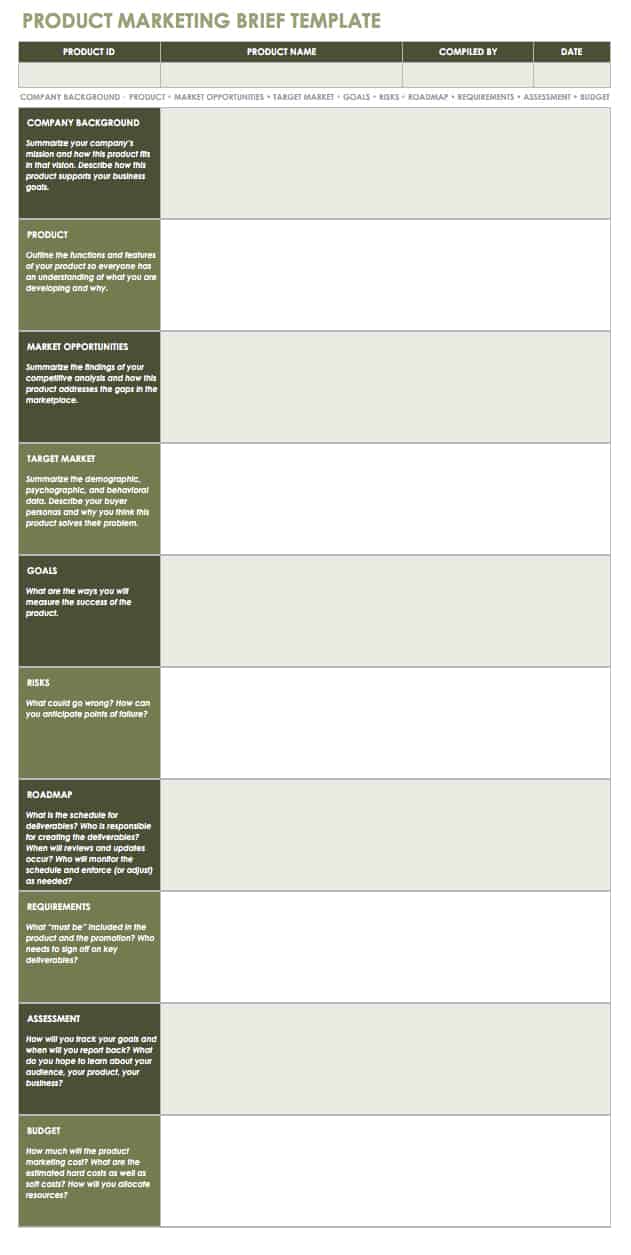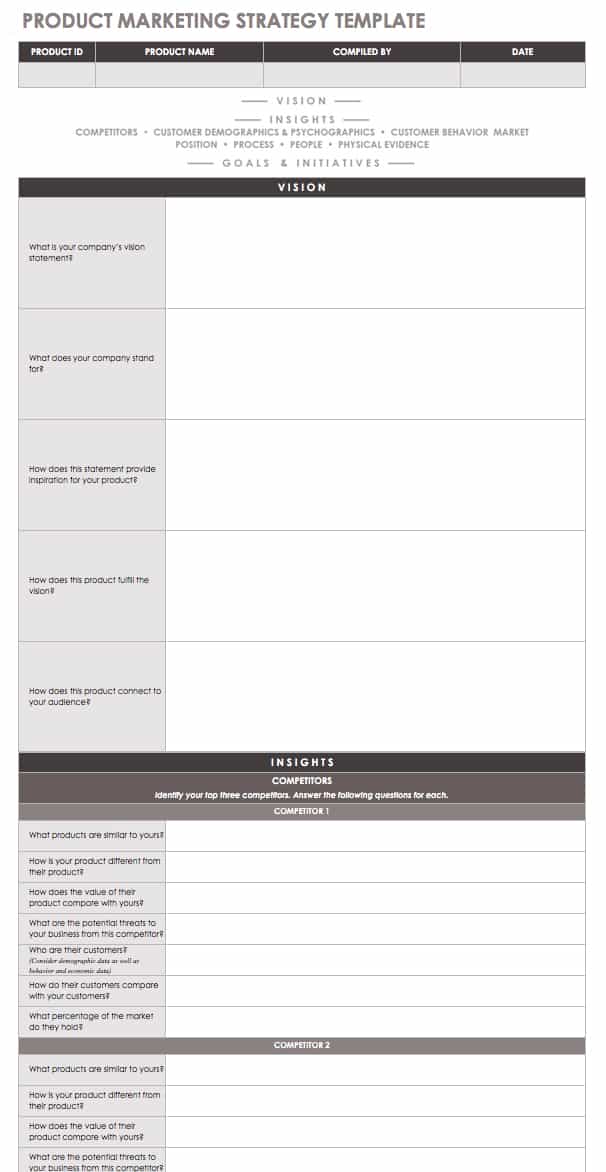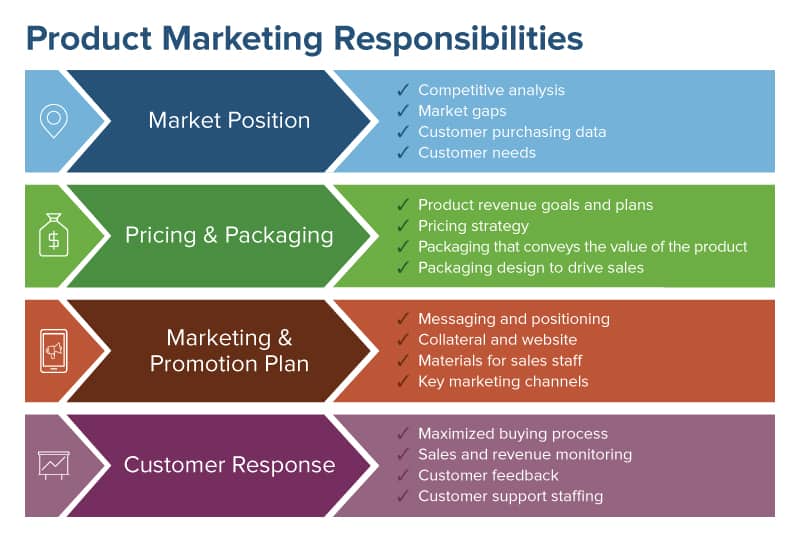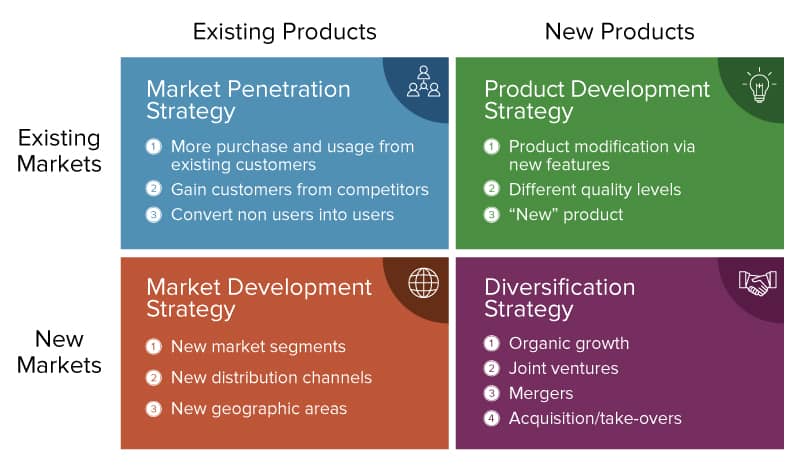How to Create and Implement a Product Marketing Plan
To help kickstart your product marketing plan, download any of the following free, ready-to-use templates to help you plan, strategize on, and track your product marketing plans.
Product Marketing Plan Template
Download Product Marketing Plan Template
Once you’ve mapped out your product’s essentials, it’s time to create the go-to-market plan that guides how it will be promoted and sold. This launch plan covers everything from developing the pricing and messaging for the product to creating training materials for your sales staff. It keeps everyone on the same page and makes sure that your team is ready when the product is ready. The plan also spells out timetables, release schedules, resources, and tasks.
Marketing Mix
You can frame your product marketing plan, or marketing mix, with the Four Ps: Product, Price, Place, and Promotion, a process developed by E. J. McCarthy in 1960. In 1981 Bernard Booms and Mary Bitner added three more components: process, people, and physical evidence. Read the Definitive Guide to Strategic Marketing Planning to learn more about the Four Ps here. These are some of the key elements you’ll need to start framing your marketing plan:
Product: While you will spell out the unique designs, features, services, and other elements that describe your product, your marketing plan covers more than the details. It’s a positioning statement that defines what makes your product different.
Price: When you set your pricing, you need to consider several factors. First, you know how much it costs to make your product. Then, you need to know how much value customers will assign your product. Consider marketplace conditions: Is your product in high demand? Are there a lot of competitors who will respond with pricing strategies of their own? What kinds of discounts, sales, payment periods, or other terms can you include with your pricing? The bottom line is that your product is only worth what your customers are willing to pay, so make sure you understand your product’s value in the marketplace.
Place: Place can mean the brick-and-mortar store where customers find your product, but it also extends to include all the distribution channels you use to get your product to your customer. (Software startups, for example, typically sell online.) Delivery methods vary widely depending on the product, but the goal is getting your product into the marketplace.
Promotion: This may seem like the most natural part of product marketing. Promotion includes all the channels and methods you will use to reach customers about the value of your product. Tactics include advertising, sales, events, email marketing, content marketing, social media, and more. Every aspect of your promotion is centered on your product messaging.
Process: Think of process as the pipeline for your product. This is especially important if you deliver a service. For a startup, the first product launch has several benefits. First, you get your product into the marketplace. Then, you also learn how to improve your process in subsequent product development. For any company, the process always reveals your strengths and your opportunities for improvement.
People: The people behind your product are critical to marketing the product. From the engineers and product development team, to sales and support, your success depends on your people. Do you have enough staff to handle the launch and product fulfillment? Have you given your sales team everything they need to explain what sets your product apart?
Physical Evidence: Successful product marketing fosters a superior customer experience. How does your messaging shape the perception of your product, whether it’s in a store or online? The consumer experience could be the biggest differentiator of your product.
The Four Ps as the Four Cs
The Four Ps are business focused, but product marketing is customer focused. To accommodate product marketing and put the customer ahead of the seller, the Four Cs approach was developed in the 1990s: Customer, Cost, Convenience, and Communication.
- Customer Solutions, Not Products: Customers want to buy a solution to their problem, not simply purchase a product.
- Cost, Not Price: What is the value of the product to the consumer, and is the price point something they are willing to pay?
- Convenience, Not Place: How easy is it for customers to find and buy your product?
- Communication, Not Promotion: Promotion is one-way messaging from the company to the consumer. By setting up social channels and other ways for customers to offer feedback and insight, you create value and loyalty.
Creating a Sales Guide
By working through the marketing mix, you will identify the differentiators and details of your product. This is the information your sales team needs. One more responsibility of product marketing is to turn these positioning statements into materials that help your sales team sell your product and achieve the company’s revenue goals. The sales guide should not focus on price, but on the differentiators of your product:
- Features and product details
- Advantages of your product
- Benefits of your product
In addition to a sales guide, you should develop data sheets, training materials, and other collateral that your sales team can use to take your product to your audience.
Coordinating the Product Launch with the Promotion
Product development and product marketing have to work in sync so both are ready simultaneously. Imagine releasing a product and not letting your customers know it’s in the market - you won’t get many sales, and you also can’t create positioning statements that are inaccurate about the product’s features and benefits. Either way, you are alienating yourself from your customers. Customer satisfaction is your primary goal, and one you can share across departments to help you achieve it.
Communicating Across Departments and Summarizing Findings
Time is your most precious resource. Don’t waste it by working independently of other departments or leaving key stakeholders out of the loop. Create a marketing brief at the beginning of your process and use it for regular updates across the organization. Your project brief should include:
- Product goals
- Timeline
- Budget
- Positioning and messaging
Product Marketing Brief Template
Download Product Marketing Brief Template
Elements of Product Marketing Strategy
A product marketing strategy goes hand-in-hand with the product strategy — the plan that identifies and defines what you want to accomplish. A good strategy points everyone (from the CEO to engineering to sales and customer support) in the same direction. It keeps you focused on your customers and your market. It’s your guide to working together on what matters most.
A product marketing strategy will have several components:
Vision
A product starts with your organization’s vision. The product must sit squarely in the strategic vision of the organization. That vision feeds the development of the product and conveys energy and excitement to your customers. It outlines your customers, what they need, and how you will address those needs. You might even get a sense of the life cycle of the product, what it could become and when it might reach its end stage.
Insights
You have a vision about what you want to achieve. Now you need the information that turns this vision into reality. Here are some vital areas:
- Your Competitors: What companies are offering what you want to offer? (Find at least the top three.) How will your product be different? What makes it unique? Who are their customers? What problems will your product solve for those customers? Competitive research, also known as a market review, is key to your success. Learn more about conducting a competitive analysis.
- Your customers: Which ones will you target with this product? What is their pain point? What is the customer or buyer persona? What are the demographic and psychographic traits (age, gender, education level, values)? What are their buying patterns? How are they using current products? How many customers will you talk to? (These conversations will help shape your product messaging down the road and help target your marketing and advertising.)
- Your market position: How will your product offer value? What is the real problem that your product solves? What are your strengths and weaknesses?
You may have had a rough idea of how you wanted your product to function. Armed with these insights, you can nail down all the details that will make customers happy and drive your business forward. You will be able to speak with confidence about the specific product functions that meet the consumers’ requirements — from features and colors, to additional services and warranties. The product description you craft tells the story of how this product meets your customers’ needs.
Understanding the Product Life Cycle
Few products last forever. From the beginning of your product, you should prepare for the growth, maturity, and drop in demand. At some point, sales will decline. Competitors will offer a comparable product. Insights are the key to identifying the stage your product is in. Always monitor the life cycle of your product and be ready with improvements, updates, or even a new product that builds on what exists. (For example, while pay phones barely exist today, the problem they once solved still exists, and has been replaced by cell phones.)
Goals and Initiatives
Management guru Peter Drucker is often quoted as saying, "You can't manage what you can't measure." That’s not only true in the C-suite, but also extends to every product and department in your company.
Once you’ve defined the product, it’s time to define what you want to achieve. Without goals, how will you know whether your product succeeds? Use simple, clear, and precise goals (whether it’s improving your market share, re-engaging with customers, or driving revenue) to keep on track. Keep in mind that the product goals don’t stand alone. They need to align with your company’s strategic and business goals. After all, your product is part of the company’s success. For more information on writing SMART (Specific, Measurable, Achievable, Relevant, Time-Bound) goals, read this article.
Finally, ask how this product fits with the initiatives of your business. Your product may be a better mousetrap. It meets customer needs by making them feel safer with fewer mice. (They buy solutions, not products.) The product also addresses the company’s initiative to move into new neighborhoods, territories, or areas. You can map your product’s features to the larger initiatives of your company.
Use the free template below to map out your product marketing strategy.
Product Marketing Strategy Template
Download Product Marketing Strategy Template
What Is Product Marketing?
The key function of product marketing is connecting your consumers to your products. Not only does product marketing require deep knowledge of your customers, but you must also understand your product and how to position it in a crowded marketplace. As the product marketer, you are responsible for the success of your product. Key deliverables include:
- A clear market position that distinguishes you from the competition
- Product pricing and packaging
- A marketing and promotion plan to help your sales channels succeed
- Analysis of customer response and keeping the product relevant
What Product Marketing Is Not
As noted earlier in this article, product marketing started as brand management and works directly with product development. While the two roles work together, they have different areas of responsibility: Product management focuses on the product and its features and requirements, whereas product marketing focuses on the customers who will use the product.
Who Uses Product Marketing Plans and Strategy?
Because product marketing is at the heart of connecting the customer to the product, everyone from CEOs to engineers and salespeople relies on their work. Internal communication across and among departments is just as important as the external messaging to customers. Everyone needs to understand the key messaging and be on the same page. Your messaging builds a strong connection among all the stakeholders in the company who are committed to the product’s success.
It’s important to get approval and buy-in from key stakeholders. Once you’ve got it, you’ll find it easier to get the necessary resources and generate excitement about your work. It’s also important to make sure all the stakeholders have what they need. A CEO may not need the sales brochures and spec sheets that your sales staff relies on in the field. The engineers may not need the strategy overview that your CEO reads. With a solid product marketing plan, you can keep everyone on message while making the relevant materials available without wasting their time.
What Does Product Marketing Do?
While all departments in a company may think about customers, product marketing puts the customer at the front and center of everything it does. The goals of traditional marketing include building brand awareness, growing new markets or audiences, and even strategic communication. By contrast, product marketing focuses solely on existing customers and keeping them happy. To succeed, you need deep knowledge of who your customers are, what they want, what influences their decisions, what problems they need to solve, and how they perceive that your business can provide a solution. Keep in mind that, while it seems as though people buy products, they are actually buying solutions to their problem. So, knowing their problem enables you to build and market the best solution to that problem.
Having this expertise gives you an influential voice in shaping the goods and services your business provides. Product marketing works with product development and the marketing and sales teams to plan the packaging, features, pricing, and promotion of the end of product. Because the work of product marketing crosses so many areas of a company, product marketing can be aligned with product development, product management, and sales and marketing. The most successful product marketers learn to work across departments, regardless of the official structure of their company.
According to David Fradin, an expert Product Leader, Product Manager, and Product Marketing Manager, product marketing emerged in the 1930s at Procter & Gamble as brand management. Over the years, the duties of the brand manager have evolved into two roles: the product developer and the product marketer. By 2015, 84 percent of the companies surveyed by Regalix Research said they invested in product marketing. You can read more from Fradin in his books: Building Insanely Great Products available now and Foundations in the Successful Management of Products, available soon from Wiley.
What Is the Value of Product Marketing?
Product marketing brings many benefits to your company. By identifying the right product and getting it to the right customers, product marketing drives sales and profits. Using customer data wisely also helps your company develop new products, as well as create smarter overall marketing strategies. In an increasingly competitive (and innovative) marketplace, product marketing is your key to success.
For start-ups, your company is your product. Product marketing is really marketing for your entire company, since the only way you can grow is by knowing your audience and knowing how your product meets their needs.
At the B2B level, product marketing faces additional opportunities and challenges. According to Kapost article by Gerardo Dada, VP of Product Marketing and Strategy at SolarWinds, B2B buyers are 57 percent through their purchase decision-making before they ever talk with a sales representative. The challenge is that purchasing decisions with B2B customers are made by a range of stakeholders, from CEOs and other C-suite executives, to sales and marketing teams. The opportunity here is to demonstrate the value of your product in a way that deepens the relationship with your customer—and can’t be duplicated by the competition.
Whether you’re just getting started or your business has years under its belt, product marketing helps your company scale by:
- Gathering and analyzing detailed information about customers
- Defining which products will meet audience needs
- Identifying and evaluating your competition
- Setting the price for the products
- Creating the go-to-market plan, with consistent messaging
As your business grows, product marketing gives you key insights into which new products and services you should add. With consumer insights, you will be able to identify needs in the marketplace and create a successful strategy. In an innovation economy, your skill at anticipating your customers’ needs (whether B2B or B2C) will help your company survive and thrive. In the digital age, customers can go anyplace, anytime to find new products and services to meet their needs - you must be one step ahead so they consistently turn to you to solve their problems.
Do You Need Help in Product Marketing?
If all your products are selling quickly and your only feedback is kind notes from happy customers, you likely have a successful product marketing strategy. However, these covert signs might indicate that you need help:
- Decisions about audience, features, and pricing are made by people who don’t have the data or understand the market.
- Products are developed and put into the market without a launch plan or a budget.
- Sales staff have to create their own collateral and spec sheets.
- Your company doesn’t have relevant data about its customers, market share, and sales.
- The role of marketing is simply to write web copy or social media messages or design brochures.
Don’t hire product marketing professionals simply to help your overworked product development team get the product finished. The jobs, while related, are not the same. Product marketing will not make the product faster. It will make the product better, because they understand what your audience needs.
How Product Marketing Aligns with Your Growth Strategy
No company wants to simply maintain its current level of revenue and audience by keeping a static line of products. Using a combination of markets and services, you can identify how your product will help your company grow. Each of the following growth strategies is based on a combination of markets and services. Growth strategies are based on:
Market Penetration: The combination of current products and current market. Your product marketing strategy focuses on increasing your market share and getting existing customers to use more of your product.
Market Development: The combination of current products and new markets. Your product marketing strategy focuses on new audiences and communities with different packaging and pricing.
Product Development: The combination of new products and current market. By listening to your audience you stay ahead of your competitors, developing new and innovative products.
Diversification: The combination of new products and new markets. Your product marketing strategy must clearly define your goals, since your current product is not growing at the rate you need for business to flourish. There are two types of diversification:
Related diversification means you develop (or buy) products that are related to your current offerings. One example is the line of beverages that Coca-Cola offers.
By contrast, unrelated diversification means you create products in a completely new area. For example, Samsung has developed solar panels, bio-tech drugs, medical devices, and more. In fact, their mission statement describes their product marketing strategy: “For over 70 years, Samsung has been dedicated to making a better world through diverse businesses that today span advanced technology, semiconductors, skyscraper and plant construction, petrochemicals, fashion, medicine, finance, hotels, and more. Our flagship company, Samsung Electronics, leads the global market in high-tech electronics manufacturing and digital media.”
There’s one more way to think about diversification: Horizontal (buying companies that are your direct competitors or are directly related to current products) and vertical (buying the suppliers and distributors of your product or developing your own channels). Each of these strategies has risks and rewards, so your decisions should be based on a solid understanding of your audience and your competitors, as well as an examination of your business strategy.
Key Growth Questions to Help with Product Marketing
Product marketing is at the intersection of product development, marketing, and sales. It covers a lot of corporate ground from defining product details, tracking customer data and market testing, creating marketing collateral, setting price and promotion strategies, training the sales staff, and even giving product presentations. To ensure your efforts stay on track with the company’s larger strategic goals, ask these questions:
- What are our revenue goals for the next year? Overall and by product line?
- What resources changes will be made in the coming year, including marketing staffing and budget?
- Do we anticipate any strategic partnerships, mergers or acquisitions?
- In which existing markets do we want to grow? What existing markets are we willing to move away from? What new markets do we plan to pursue?
- What existing services do we plan to maintain and improve? Which are at the end of their life cycle? What new products are being discussed?
- What are the biggest challenges we will face this year?
The Future of Product Marketing
David Fradin is a Distinguished Professor of Practise and Advisor, and Product Management Programs at Manipal Global Academy of Information Technology. He is also the author of Building Insanely Great Products and the soon-to-be-released Foundations in the Successful Management of Products, available soon from Wiley. Fraudin thinks the biggest change in the role of product marketing is the advent of social media and tools to manage social media.
“The product marketing manager should be working strategically not tactically, thereby developing and maintaining the product’s marketing strategy including social media,” explains Fradin. “Social media is a huge part of marketing now and it is important for both business-to-consumer and business-to-business marketing and sales.”
He also recommends a shift in titles to reflect the changes in product marketing. “The product marketing manager’s title should be changed to product marketing success manager to reflect the actual role played,” he adds. “They are given the budget for the marketing that needs to be done, so they have the authority they need to go with their responsibilities. Accordingly, they should not be the demo god. That should be done by pre-sales support.”
Improve Product Marketing Plans with Smartsheet for Marketing
The best marketing teams know the importance of effective campaign management, consistent creative operations, and powerful event logistics -- and Smartsheet helps you deliver on all three so you can be more effective and achieve more.
The Smartsheet platform makes it easy to plan, capture, manage, and report on work from anywhere, helping your team be more effective and get more done. Report on key metrics and get real-time visibility into work as it happens with roll-up reports, dashboards, and automated workflows built to keep your team connected and informed.
When teams have clarity into the work getting done, there’s no telling how much more they can accomplish in the same amount of time. Try Smartsheet for free, today.





